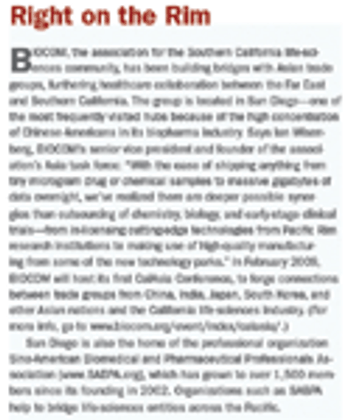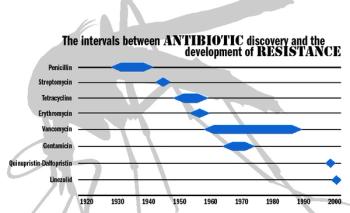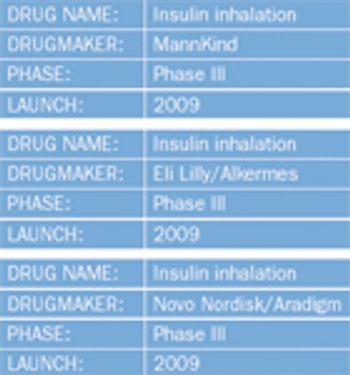
Concerns over quality? It's not stopping Big Pharma outsourcing and venture capital.

Concerns over quality? It's not stopping Big Pharma outsourcing and venture capital.

Roche has always gone its own way with biologics, deals, and new medicines. Now that the rest of industry has caught on, how can Roche stay ahead of its time?

US officials think they can control MRSA and other "superbugs," but dangerous bacteria know no boundaries. What does the world do when its drugs stop working?

Pharm Exec asks experts to predict what 2008 has up its sleeve for the industry--from the top line to the bottom line, from R&D to M&As, from Congress to the courts.

Novartis' Paul Herrling talks about how Big Pharma can learn from nonprofit R&D and collaborate to get an edge on the drug safety problem.

Getting innovative drugs into bodies just got a whole lot more interesting. Here's how the delivery biz is keeping up with pharma's R&D.

You couldn't call it a gusher, but the pipeline has still has some life in it, and important new therapies are working their way toward approval. Have we turned the corner? Judge for yourself, with the help of this guide to 61 of the best new products in development.

There are plenty of new vaccines on the market, but for patients to get maximum benefit from them, payers and even physicians need to rethink their roles in prevention.

FDAAA aims to restore public trust in drug safety regulation but may curb investment in R&D

Will CROs continue to operate in India, or will Novartis' pullout send them farther East?

Cancer R&D IS booming right now. At a time of poor ratings on both Wall Street and Main Street, pharma can at least point proudly to its oncology pipeline as proof that it still takes big risks to make big advances against big killers-and win. According to a recent IMS report, the cancer pipeline contains 380 compounds, with nearly 100 in Phase III. The long-established standard of care-surgery, radiotherapy, and chemo-is fast giving way to a high-tech array of targeted therapies. These molecules and antibodies are designed to block specific disease pathways, and they are proving both far more effective and far more tolerable than the sledgehammer status quo. Since 1996, the overall survival rate for patients has jumped by 30 percent, from one-half to two-thirds.

David Barlow is the closest thing you can find to a pharma-industry ecologist. He takes companies that deal with technology that Big Pharma won't touch and turns them into drug powerhouses.

The clinical trials space these days is an alphabet soup of technologies: CTMS (clinical trial management systems); CDM (clinical data management); CDR (clinical data repositories); eCTD (electronic common technical document); and many more. But the technology with the most promise for transforming the way clinical trials are performed (and for driving everyone mad throughout implementation) is EDC-electronic data capture. It's taken more than a decade, but today most big pharma companies-and a fair number of smaller ones-are using some form of EDC in clinical trials. The early adopters might have experienced some growing pains, but the benefits seem to be outweighing the high cost of implementation. Few companies would consider going back to paper-based trials.

The Association of the British Pharmaceutical Industry is challenging the UK government over the financial incentives being offered by the Department of Health (DH) to encourage doctors to switch patients from on-patent medicines to specific generic alternatives. ABPI believes the way the incentives are structured contravenes EU law-if pharma companies were to offer similar payments, they would be in serious trouble.

That was the collective vow sworn by Big Pharma last December following Pfizer's $1 billion–down–the–tubes withdrawal of the cholesterol compound they had touted as the most important drug of the decade. The question is, What's the right organizational construct to support innovation-or at least to stop Phase III failures?

Have you heard the rumors that all the drugs have already been discovered? Well, forget it. Maybe some of the low-hanging fruit is gone-but in the last few years, science has opened up thousands of new targets, while new technologies have made it possible to treat disease in unprecedented ways.

Scare stories about antibiotic-resistant bacteria are all too common in the mass media these days. In the United Kingdom alone, the number of deaths from methicillin-resistant Staphylococcus aureus almost doubled between 2001 and 2005 to more than 2,000. The situation with Clostridium difficile is even worse, with UK deaths tripling to almost 4,000 over the same period. The big problem is that the incidence is growing, yet few antibiotics are being developed that will be able to kill the resistant bacteria.

As the industry focuses its attention on the upcoming renewal of the Prescription Drug User Fee Act (PDUFA), there is a tendency to overlook two other significant pharmaceutical programs coming up for renewal and a related piece of legislation that has been introduced:

Comparative drug tests make pharma see red. But market pressure to prove a drug's real-world value is likely to force even the most stubborn firm into the ring. Why be bull-headed? Adaptive trials can cut cost, time, and risk in half.

A lot of the viruses that are being worked on today are genetically engineered to target the cell and crank out a drug that will kill it. But in our case, we don’t need a drug-the reovirus does it all by itself.

Doctors want to know what's hot in the market, not read a new brochure on a nine-year product that doctors have already been using.

To one major legal scholar, drug safety regulation isn't just about meeting standards, it's about what you take away from one group of patients in order to benefit the rest.

This year's Pipeline Report profiles 32 compounds that are the early fruit of pharma's investment in targeted drug design. In diabetes, HIV, hepatitis C-and especially oncology-vibrant R&D is set to revolutionize treatment with new classes of drugs over the coming decade. We spotlight today's geeky names-the DPP-IVs and MK-0518s, the Tykerbs and Telaprevirs-that are most likely to be tomorrow's glam blockbusters. Even the year's downers-we're still waiting on Acomplia, Exubera is failing to live up to the hype-are reminders of how improvements in drug development, such as Phase 0, are helping industry in its drive to become more effective. Although riskier than squeezing me-too drugs out of proven products, targeted R&D is lighting pathways not only to cures of killer diseases but to a fresh paradigm of progress and profits, and to renewed confidence in the pharmaceutical industry. From where we stand, the future looks bright.

New partnerships with nanobiotech firms are helping pharma companies overcome solubility problems and extend profitable product lifecycles.

A new European collaboration of biotech, pharma, academia, and government takes up the challenge of boosting R&D.